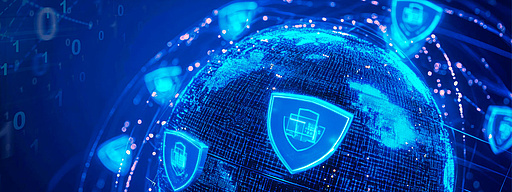
Mobile devices: popular among users – and cybercriminals
Mobile work with tablets or smartphones continues to be a top trend among companies, end users and – of course – cybercriminals. Intelligent enterprise mobility management (EMM) can significantly reduce the risk of falling victim to a cyberattack.
In short
- Telework and other forms of mobile working have become routine since the start of the pandemic in 2020.
- Smartphones and tablets are widely used by remote and mobile workers.
- Criminal hackers are increasingly attacking mobile platforms to crack accounts and prepare further attacks.
- Enterprise Mobility Management (EMM) helps IT teams reliably protect smartphones and other mobile devices from hackers.
According to the 2022 Verizon Mobile Security Index Report, 45% of
632 business professionals responsible for buying, managing and securing mobile devices said they had suffered a security compromise in the preceding 12 months. Almost 80% said that the
shift to mobile work had adversely affected their organization’s cybersecurity. Just over 60% whose companies operate internationally were more likely to have been affected.
The 2022 US Cybersecurity Census Report from the Ponemon Institute
reported more than a quarter of 516 organizations surveyed said they lacked a remote connection management solution to secure remote access to IT infrastructures.
Mobile attack vectors have grown along with user reliance on messaging apps. For example, cybercriminals increasingly are sending a text or WhatsApp message with a bogus reference to a
supposed online order and instructions to click a bogus link to confirm order payment or delivery arrangements. Once clicked, malware is installed on the smartphone. In
fact, most of the mobile malware available on the dark web focus on that or similar attack vectors.
If the smartphone is locked, the damage may be limited. However, users may not realize that malware has installed a keylogger that can capture online personal and business
account credentials. Cybercriminals can then gain access to accounts at will.
Cracking M365 access via smartphone
It is particularly damaging if attackers obtain access to a Microsoft 365 account. That enables them to wander freely through reams of business emails, files, contact lists
and other data to prepare even more damaging attacks on company personnel. Those can range from blackmailing highly compensated executives to sending requests to executive assistants for
financial transfers or sensitive intellectual property.
To prevent such attacks, all devices including traditional PCs, laptops and mobiles with access to corporate networks need to be protected.
Manual configuration hardly feasible
With a rapidly growing number of company- or user-owned mobile devices used for business, it’s increasingly time-consuming for IT admins to configure all of them manually.
That be even more difficult for or even impossible for devices used by remote employees and those who travel frequently.
That’s where Enterprise Mobility Management (EMM) comes in. EMM encompasses provisioning, configuring and
maintaining mobile devices and allows IT teams to manage all aspects of mobile device usage from a single, integrated admin interface, including:
- Mobile Device Management (MDM) for hardware
- Mobile Application Management (MAM)
- Mobile Content Management (MCM)
EMM with UEM – the benefits
A modern EMM solution such as the baramundi Mobile Devices module in the baramundi Management Suite provides comprehensive options for quickly and easily managing mobile devices. It covers:
- Fast, easy and consistent setup of devices using automation
- Network transparency with automated inventory of all devices
- Use of binding and, above all, enforceable compliance rules to increase security
- Reliable separation of company and user personal data and applications
- Support for a wide range of device and usage types such as BOYD (Bring Your Own Device), COPE (Corporate Owned, Personally Enabled) and COSU (Corporate Owned, Single Use)
New devices can be provisioned and others already in use can be enrolled under IT management. All of them can be equipped with appropriate applications, security policies and settings, and immediately inventoried according to user and company requirements.
Observe data privacy
The separation of business and private use ensures compliance with data protection and user privacy requirements, and devices can be authorized to access the corporate
network only for a specific purpose or time period.
The biggest plus is that all management options, such as the installation of updates, patches and hotfixes, can be centrally monitored, controlled and
coordinated. EMM makes life massively easier for IT teams through the use of automation. It also provides greater security because IT can detect and close security
gaps quickly and significantly reduce the risk of cyberattacks with appropriate security settings, application whitelisting and blacklisting, and other measures.
Mobile devices under control
Read our free whitepaper “Enterprise Mobility Management (EMM) – What do management solutions do today?” to learn more about device enrollment and inventory across all major platforms, securing through remote lockdown and jailbreak detection, centralized updating, and user self-service.
Read more
Cyber resilience: the most important trends for secure endpoint management
The ingenious principle of Linux software management
- Tags:
- uem,
- bms,
- linux,
- managed software


